Nokia’s Mobile Search
Yesterday Nokia announced Mobile Search:
Nokia today introduced a pioneering mobile search software solution that provides users with easy and fast access to leading search engines directly from their Nokia handset. The search application is a simple, convenient, and fast way for Nokia smartphone users to find and connect to any website as well as local search engines, whenever, wherever. The current service and content providers incorporated in the search application include Eniro, Fonecta, Medio Systems, Yahoo!, Yell.com, as well as digital map solution provider AtlasCT and digital map data provider NAVTEQ.
If you have not tried this yet, you should, it is a very handy tool. Of particular note in my opinion is the local search functionality. This allows you to search for businesses in your local area (or an area you specify). You are provided with a list of results and from this you can do several things: dial the relevant numbers, add the number to your Contacts, and view a map with the location of the results pinpointed. Much of this information may be available via your Operator's portal, for example Orange in the UK provide a 'Where's My Nearest...' service. However, because Mobile Search is an application it is easier to use, it's faster in getting to results and it's better integrated into the phone. More than anything, Mobile Search demonstrates the power of the service type application when compared to its mobile browser equivalent.
The Local Search in the UK is provided by Yell. Enter a business name or type and a location and it returns a list of results. Being a Symbian application, it is tightly integrated into the phone. This is best illustrated in screenshots:
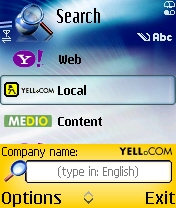
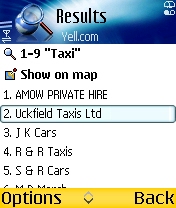
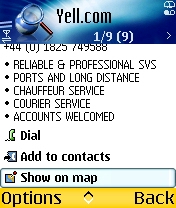
Carry out a search, viewing the search results list and the detailed information view.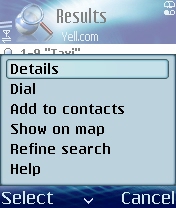
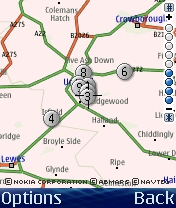
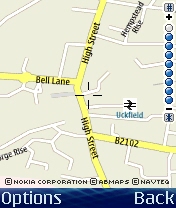
Context menu for actions, viewing a map showing location of search results, and zooming the map in.
The Web Search and the Image Search are provided by Yahoo. A web search returns a list of results which you can get further information on (the title, and a brief description). You can also choose to add a result to your Bookmarks or to Browse to it (using the phone's Web application). An Image Search returns a similar list with the addition of small thumbnails alongside each result. Clicking on a result takes you to a larger thumbnail (the detailed information screen) from which you have the option to retrieve and save a larger image.
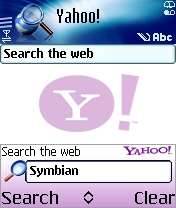
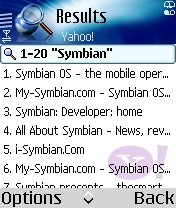
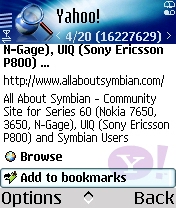
Searching the web, the subsequent results, and the detailed information screen.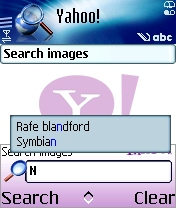

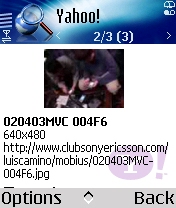
Searching for images, a list of results with small thumbnails and the detailed information screen.
In tests that I ran I found that doing a search was approximately three times quicker using Mobile Search (open Mobile Search, perform search, and view results) than it was using the Web application (open Web, access and load Yahoo Mobile Bookmark, perform search, and view results). Local searches have a greater time saving, especially if you use the mapping functionality.
The presentation of results is much better (especially on images). The advantage for a service type application is that it can display more information about a given result without additional network connections. In all searches within the Mobile Search application there is one network connection round trip. The first list displayed is simple (results screen with one result per line list), and more information (detailed information screen) is only one keypress away. This compares to a browser-based search solution where you must either include all information onto a single page (making results harder to read) or accept that more information requires an additional network connection round trip.
The integration with the built in applications (browse to a result, add to bookmarks, dial, add to contacts) results in a much better user experience. This is at is most noticeable in local search where it is possible to find a local taxi company, view its location on a map (and zoom in or out for clarity), and call the company, all from within the Mobile Search application. You can book a taxi in less than a minute from a standing start, which is not only very impressive, but very usable in the real world. Local Search services available do vary by country (currently UK, Finland and Sweden), but the application will change the local service used when it detects (via the Network) that you have changed countries. Further search types can be added via plugins, raising the possibility of Google or other search sources being supported. Mobile Search could become a one stop solution for any type of search on the device. Some of the possibilities are plugins that allow an internal search (searching your calendar, notes, email and contacts), an eBay search, an Amazon search, and so on. Since mapping data comes from a separate source to the local services data it can easily be combined with other search services or used on its own.
Nokia's Mobile Search ably demonstrates how it is possible to build a powerful and easy to use service type application. That is to say, an application which retrieves information from one or more sources (services), displays it on the mobile device and looks to integrate that information into the functionality of the device on which it is being accessed.
The end functionality provided may be available via the browser through Operator and Search Portals, but the user experience is completely different.
Mobile Service Consumption
Steve talked about the benefits of off board data solutions (i.e. Internet-based) and of course this is part of the power of this type application - it allows access to almost unlimited indexes of information. More than that, I think Nokia's Mobile Search is a good example for how, in the future, we will consume information on mobile devices. Consumption will be service application (rather than browser) led.
I have often been heard to say (to those that will listen to my waffle) that the mobile user experience is the key to the future. This is what the service application type does. It nails the user experience by using the full power of the phone’s features and by providing a familiar user interface. This is something that is hard to do well in a mobile browser with the result that few people use the available services and subsequently fewer services are developed and deployed. It is not without reason that a route finding application such as WayFinder has been popularising smartphones in the mainstream. With its off board data model, it's an example of a service type application. While advanced service type applications are obvious for more complex services such as navigation their use in simpler scenarios at first glance seems less obvious, but this is to misunderstand mobile. While on the desktop, service applications work well through the browser, the same is not true of mobile devices. It is necessary to think of mobile and desktop as different paradigms and design applications and service provision accordingly.
This is not to say there is no place for mobile browsers, but they are not the same containers they are on the desktop. Instead they are a conduit for the display of information from service applications, and are of primary use when you move outside the areas covered by service applications. It is worth noting that both Opera and NetFront recognise this, in the Opera Platform and Netfront Dynamic Menu model there is an attempt to add service type application functionality to the browser by more tightly integrating with the phone. This browser-led model could be successful because it demonstrates different thinking to the desktop, but I think service applications are more likely to succeed because they have greater flexibility.
For the majority of Mobile Internet use, the service type application is a better approach in terms of ease and speed of use. As with most software systems, it's all about the mobile user experience.
